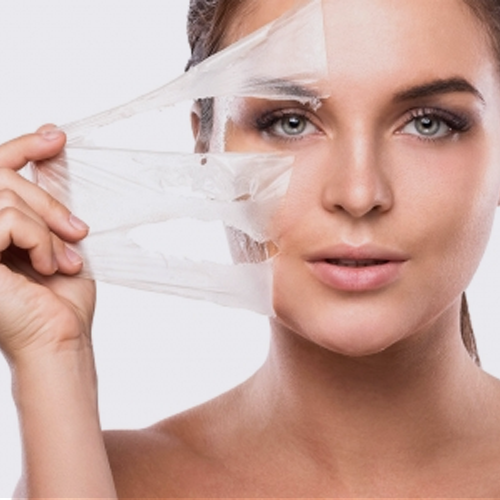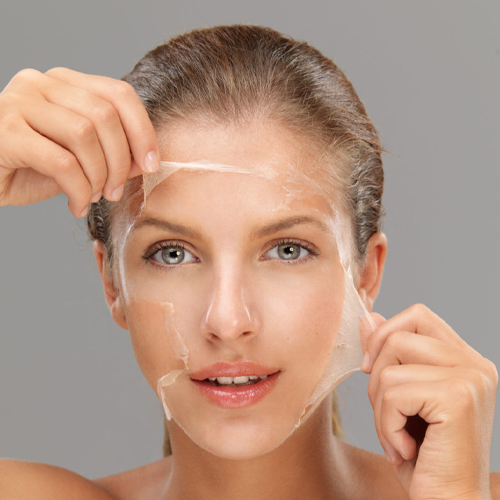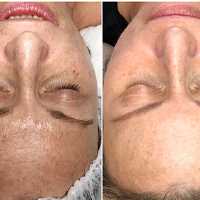Service
CHEMICAL PEEL
Best Chemical Peel Treatment in Islamabad
Chemical peels can improve the skin’s appearance. In this treatment, a chemical solution is applied to the skin, which makes it “blister” and eventually peel off. The new skin is usually smoother and less wrinkled than the old skin. Chemical peels can be done on the face, neck, or hands. They can be used to:
- Reduce fine lines under the eyes and around the mouth
- Treat wrinkles caused by un damage and aging
- Improve the appearance of mild scars
- Treat certain types of acne
- Reduce age spots, freckles, and dark patches (melasma) due to pregnancy.
- Improve the look and feel of skin
How does Chemical peel work?
There are three basic types of chemical peels:
- Superficial or lunchtime peel: Alpha-hydroxy acid or another mild acid is used to penetrate only the outer layer of skin to gently exfoliate it. The treatment is used to improve the appearance of mild skin discoloration and rough skin as well as to refresh the face, neck, chest or hands.
- Medium peel: Glycolic or trichloroacetic acid is applied to penetrate the out and middle layers of skin to remove damaged skin cells. The treatment is used to improve age spots, fine lines and wrinkles, freckles and moderate skin discoloration. It also can be used to smooth rough skin and treat some precancerous skin growths, i.e. actinic keratosis.
- Deep peel: Trichloroacetic acid or phenol is applied to deeply penetrate the middle layer of skin to remove damaged skin cells. The treatment removes moderate lines, age spots, freckles and shallow scars. Patients will see a dramatic improvement in skin appearance. The procedure is used on the face and only can be performed once.


How does Chemical peel work?
There are three basic types of chemical peels:
- Superficial or lunchtime peel: Alpha-hydroxy acid or another mild acid is used to penetrate only the outer layer of skin to gently exfoliate it. The treatment is used to improve the appearance of mild skin discoloration and rough skin as well as to refresh the face, neck, chest or hands.
- Medium peel: Glycolic or trichloroacetic acid is applied to penetrate the out and middle layers of skin to remove damaged skin cells. The treatment is used to improve age spots, fine lines and wrinkles, freckles and moderate skin discoloration. It also can be used to smooth rough skin and treat some precancerous skin growths, i.e. actinic keratosis.
- Deep peel: Trichloroacetic acid or phenol is applied to deeply penetrate the middle layer of skin to remove damaged skin cells. The treatment removes moderate lines, age spots, freckles and shallow scars. Patients will see a dramatic improvement in skin appearance. The procedure is used on the face and only can be performed once.

How are chemical peels performed?
A chemical peel can be performed in a doctor’s office or in a surgery center as an outpatient procedure. Your skin will be thoroughly cleansed with an agent that removes excess oils, while your eyes and hair are protected. A chemical solution is then applied to your skin. Chemical solutions typically used include glycolic acid, trichloroacetic acid, salicylic acid, lactic acid or carbolic acid (phenol). The different types of chemicals cause a controlled injury, each penetrating through to a different skin depth, then peeling away to reveal a new layer of skin.
The different chemical solutions provide different results. The choice of a chemical depends on your goal. You will work with your dermatologist to determine the depth of your peel.

How are chemical peels performed?
A chemical peel can be performed in a doctor’s office or in a surgery center as an outpatient procedure. Your skin will be thoroughly cleansed with an agent that removes excess oils, while your eyes and hair are protected. A chemical solution is then applied to your skin. Chemical solutions typically used include glycolic acid, trichloroacetic acid, salicylic acid, lactic acid or carbolic acid (phenol). The different types of chemicals cause a controlled injury, each penetrating through to a different skin depth, then peeling away to reveal a new layer of skin.
The different chemical solutions provide different results. The choice of chemical depends on your goal. You will work with your dermatologist to determine the depth of your peel.
Why CHEMICAL PEEL TREATMENT?
Less Down Time
light chemical peels do not require much down time and medium and deep chemical peels can require two to three weeks of recovery time
Treat Many Prblems
Reduce age spots, freckles, and dark patches (melasma) due to pregnancy or taking birth control pills.
Improve Skin Appearance
can improve the skin‘s appearance. In this treatment, a chemical solution is applied to the skin, which makes it “blister” and eventually peel off.
Generally, fair-skinned and light-haired patients are better candidates for chemical peels. If you have darker skin, you may also have good results
Effective
It is the most effective way of skin cleansing because it deep down to the inner layer of skin. It can be done on the face, neck, or hands.
Treating Hyperpigmentation
Treating hyperpigmentation and other skin discolorations, deep chemical exfoliation, reducing the depth of wrinkles or acne.
CHEMICAL PEEL TREATMENT






FAQs
How Many Types Of Chemical Peel?
you’ll choose a chemical peel in one of three depths:
- Light chemical peel. A light (superficial) chemical peel removes the outer layer of skin (epidermis). It’s used to treat fine wrinkles, acne, uneven skin tone and dryness. You might have a light peel every two to five weeks.
- Medium chemical peel. A medium chemical peel removes skin cells from the epidermis and from portions of the upper part of your middle layer of skin (dermis). It’s used to treat wrinkles, acne scars and uneven skin tone. You might need to repeat the procedure to achieve or maintain the desired result.
- Deep chemical peel. A deep chemical peel removes skin cells even deeper. Your doctor might recommend one for deeper wrinkles, scars or precancerous growths. You won’t need repeat procedures to get the full effect.

